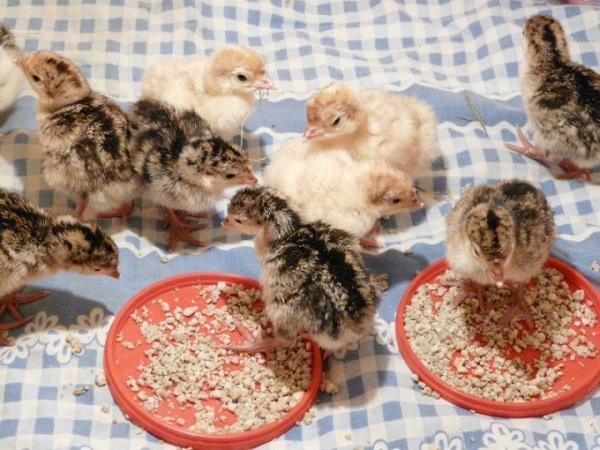Poultry keeping and breeding of turkeys
 Turkey breeding usually starts with the acquisition of chicks. Daily chicks require increased attention and a warm room, therefore, if there are no suitable conditions for poultry farming, it is recommended to purchase at least weekly turkeys. In addition, they are already vaccinated against smallpox and neurological diseases and have a certain immunity.
Turkey breeding usually starts with the acquisition of chicks. Daily chicks require increased attention and a warm room, therefore, if there are no suitable conditions for poultry farming, it is recommended to purchase at least weekly turkeys. In addition, they are already vaccinated against smallpox and neurological diseases and have a certain immunity.
When buying day old chicks, they must be vaccinated, and also protected from contact with other birds. A fragile turkey body easily picks up various diseases.
One of the main conditions for keeping chicks turkeys is to provide them:
- suitable temperature regime;
- lighting;
- diet.
Temperature regime
For chicks, you need to prepare a large box or plywood box with high sides (at least 50 cm), since they have great jumping ability. Put a heating lamp on top, while ventilation holes should be made along the top of the box so that the chicks do not get steamy.
Unlike chickens, ducks and geese, turkeys are very afraid of drafts, especially young ones, so it is important to exclude them.
At first, the temperature should be at least 35 degrees Celsius. It is very important to provide a warm bedding so that the legs do not freeze. For this, you can use ordinary heating pads. Cover the top of the heating pad with cardboard or a piece of cloth, especially if the box is on the floor, but it is better to put it on a hill, for example, on stools. The litter should be changed as it gets dirty to keep the poultry feet dry at all times.
By the end of the second week, the room temperature can be gradually reduced to 27 degrees Celsius, and in the third week, 22 degrees will be enough.
You can not abruptly transfer turkey poults from a warm room to a cold one - they can get sick with colds.
Lighting
It is recommended not to turn off the light for turkeys for the first week at night, it should be on constantly. From the second week, the light can be turned off for several hours a day. At three weeks of age, turkey poults can easily do without night lighting.
The more intense the lighting and heating at first, the faster the turkey poults grow and develop.
Turkey poultry diet
For feeding small turkeys in poultry, it is recommended to use special feed for them, in extreme cases, compound feed for broiler chickens is also suitable. In addition, during the first week, millet and chopped boiled eggs can be added to the chicks' diet. For small turkey poults, millet should also be boiled - this way it is better absorbed. Upon reaching 2 weeks of age, they give raw cereals. From the third week, greens are gradually introduced into the menu - cabbage, nettles, garden herbs scalded with boiling water.
The first 2-3 weeks of day old turkey poults should be fed frequently. Dry compound feed must be poured into the trough at all times. But wet mash must be cleaned after the chicks eat so that they do not sour, and be sure to wash the feeders after each feeding.
You need to feed the turkey poults every 3 hours, at least 7-8 feedings per day. In month-old chicks, the frequency of feeding is reduced. At the age of 2 months, 4 meals a day are enough. After reaching the age of 1 month, grain can be introduced into the diet of turkey poults.
Turkeys are prone to obesity, so they should not be fed and given a lot of dry food. Greens should be the basis of the diet.
Features of breeding turkey poults with a turkey
The most ideal option for poultry farming is to breed turkey poults with a turkey, she never abandons chicks. For 7 turkeys in a herd, 1 turkey is enough. Several turkeys can lay eggs in each other's nests, but each sit in its own. They rush directly to the floor, but it is better to put large boxes. Turkeys sit on eggs starting in March and sit for 27 days.
Care must be taken to ensure that the turkey gets up to eat. Feeders should be placed near the nest, as well as containers with ash so that she bathes (to prevent the appearance of parasites). If the turkey does not get up to eat by itself, it should be forcibly lifted and brought to the food. While she is eating, you can check the eggs and remove the crushed ones.
Turkeys are one of the best mothers, they always return to eggs after feeding and are able to take other people's chicks under their wing.
How to equip a turkey barn
To breed adult turkeys, a spacious room will be required, since the birds are very large and can grow up to 20 kg. It is necessary to exclude the possibility of drafts, as well as to build a warm floor - earthen or wooden. It must be kept dry at all times. The best option is an earthen floor that absorbs moisture. To do this, cover the ground in the barn with sawdust, and throw straw or hay on top. In a turkey shed, it is necessary to build perches, as for chickens, but choose thicker sticks due to the large weight of the birds.
In cold weather, the room temperature should not drop below 15 degrees Celsius. If it's cold in the barn, the turkeys will lay, but they won't sit on the eggs.